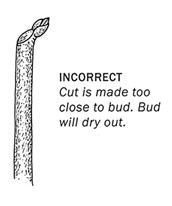WHAT TO DO IN THE GARDEN IN EARLY SPRING
By Rosanne Loparco
Get ready to garden! It’s been a long winter, but there are some general chores you can start to get your garden ready for the season. Keep in mind that you still have to take the spring weather conditions into consideration. Refrain from any planting until the soil and air temperature is above 50 degrees. Any tender annual plants left outdoors and/or planted in the ground MUST consistently have these air and soil temperatures in order to survive. New perennials and many trees and shrubs can be planted in spring; many will tolerate those few colder days.
Clean up Winter Debris. Walk around your yard and pick up twigs and other debris. Once the ground has warmed, rake the lawn to fluff the grass, improve aeration, and remove thatch. Winter can cause damage to trees and shrubs; prune out any damaged branches. Plants that have “heaved” from the freezing and thawing action of the soil should be replanted as soon as the soil is workable. A layer of leaves or straw will help protect exposed root masses if the soil is still a little frozen. Remove winter mulch coverings when the temperatures are warmer. Stay on top of weeds. Weeds start to grow early; remove them as you see them while the roots are still shallow.
Perennials. Be patient; it can sometimes take awhile for perennial growth to emerge. Cut back perennial grasses and other perennials that you left up for winter interest or those plants you didn’t get to clean up in the fall. Ideally, you want to be sure your perennial beds are cut back before the new growth gets more than a few inches high so that you won’t damage the new growth while cutting back the old. Once the soil is workable, spring is a great time to plant new perennials as well as divide existing perennials such as hosta, daylilies, or Shasta daisies.
Vegetables and Fruits. Take this early spring timeframe to plan out your vegetable garden space. Be sure to practice crop rotation: do not plant members of the same plant family in the same spot as last year. Rotating the plants in your vegetable garden is a method to control disease and insect problems. If you’re limited in space, definitely consider vegetables in containers. Many vegetables will do great in a container, provided you use good quality potting soil (not garden soil) and keep the plants nourished, with a regular regimen of a water-soluable fertilizer, and keep them well watered during the growing season. You must never let your veggies dry out; they will not be able to recover and bounce back as flowers can. Cool season vegetables like lettuce, spinach, or swiss chard can be planted earlier than warm season vegetables such as tomatoes or peppers. Cool season vegetables can tolerate temperatures about 50 degrees and garden soil that is also at least 50 degrees and workable; i.e., dry enough not to stay in a clump when squeezed in your hands. Consider planting cool season vegetables in pots or window boxes for earlier harvesting. Warm season crops must wait until soil and air temperatures are consistently warmer. Cornell University’s horticultural website provides useful growing guides for most edible crops. Visit http://blogs.cornell.edu/horticulture/ , click on “vegetables” for more information. Don’t forget to try fruits in your garden! This is a great time to think about adding some fruit crops such as strawberries, blueberries or raspberries to your space. Visit Cornell’s website for fruit growing guides.
Roses and Bulbs. Cut back and prune roses when forsythia blooms (or before the roses are leafed out). Cut back dead or crossing canes to about one quarter of an inch above an outward facing bud. Roses such as the “Knock Outs” really only need pruning to cut out dead wood or a minor prune to shape. Fertilize spring blooming bulbs when the leaves first appear.
Pruning. Once the snow melts, remove broken branches only. Then wait until the temperatures are consistently warmer and shrubs leaf out and new growth begins for actual pruning. This will allow you to know for sure which parts of the shrub are really dead. Give your shrubs a chance; do not prematurely give up on them. Spring is a good time for pruning many shrubs, including evergreens. The exception to this is any spring blooming shrubs like forsythia and lilac. Those should be pruned only after flowering. As a general rule, if you’re not sure about pruning flowering shrubs, prune after flowering. For specific information on pruning individual species of trees and/or shrubs, there’s some great information on the Cornell University tree and shrub website at http://blogs.cornell.edu/horticulture/trees-shrubs. When you begin your cuts, look at these diagrams for the correct versus incorrect way to make the cut:



Groom Your Tools. If you didn’t clean your tools before you put them away, get them groomed before you use them. Clean and sharpen cutting tools, such as hand pruners and flower shears, and digging tools, such as hoes, spades, and trowels. Clean and sharp tools go a long way to preventing the spread of plant diseases.
